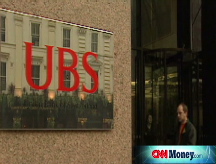Banks brace for more pain
Most banks did better than expected in the second quarter. But concerns about capital, credit and housing are likely to weigh on the sector for the rest of the year.
NEW YORK (CNNMoney.com) -- With the latest earnings season in the rearview mirror for most of the nation's banks, investors can breathe a little easier.
At least for now.
As the final numbers continue to trickle in, financials, as a group, managed to fare a bit better than most analysts were anticipating.
In fact, over half of the financial services firms in the S&P 500, which include everything from regional banks to securities firms, managed to beat earnings expectations during the second quarter, according to Thomson Reuters.
Of course, several banks merely reported smaller losses than forecast. Overall, the financial sector is expected to report total profits of just $8.9 billion in the quarter, down 85% from earnings of $61.3 billion a year ago.
"If they were better than [Wall] Street estimates, it's just a function of how low the estimates were," said Scott Sprinzen, a bank analyst and managing director at Standard & Poor's.
The latest quarterly results, along with the Securities and Exchange Commission's recent plan to limit "naked" short selling on several large banks and brokers, fueled the rally in the financials earlier this week, analysts said.
But skepticism returned to the market towards the end of the week. Shares of savings and loan Washington Mutual (WM, Fortune 500) and regional bank Wachovia (WB, Fortune 500) have dipped on concerns about their liquidity and continued fears about the housing market.
Doubts also remain about whether the proposed government rescue plan for mortgage financing giants Fannie Mae (FNM, Fortune 500) and Freddie Mac (FRE, Fortune 500) will help those two troubled companies.
Heading into this earnings season, banks were dogged by the twin investor fears of credit and capital.
Analysts were betting that banks would once again have to beef up their loan loss reserves as the housing market deteriorated further and as the U.S. economy continued to sputter.
Banks did just that. At the same time, nonperforming assets and net charge-offs, or loans banks don't think are collectable, continued to rise.
And some new fears were added to the proverbial fire this time around as companies like JPMorgan Chase (JPM, Fortune 500) hinted at signs of deterioration in previously insulated areas like prime mortgages.
Management at most firms acknowledged that they were bracing for more losses ahead, but a handful of top execs broke from routine, hinting that the explosive growth in credit costs could be nearing a peak.
Ken Lewis, chairman and CEO at Bank of America (BAC, Fortune 500), told analysts that credit losses would remain an issue, but added that they were manageable.
Just a day later, top executives at Washington Mutual, the nation's largest thrift, didn't rule out further loan losses altogether, but the company said it expected provisioning to peak sometime this year. The company added that it was seeing early signs of stabilization in some of their home loan portfolios including subprime.
But banks also put their best foot forward when it came to capital.
Most firms appeared well capitalized despite the losses this earnings season, keeping their Tier 1 capital ratio above 8% - generally considered a good sign for a financial institution.
And other than Merrill Lynch's (MER, Fortune 500) sale of its stake in the media outlet Bloomberg LP for just over $4.4 billion, most financial companies avoided announcing any major capital raises, particularly through issuing common shares.
"That is the big thing that concerns investors - will they suffer additional dilution as they [banks] raise additional capital?" said Walter "Bucky" Hellwig, senior vice president at the Birmingham-Ala.-based Morgan Asset Management, which oversees about $30 billion.
Just two large banks - Wachovia and Regions Financial (RF, Fortune 500) - cut their dividends to preserve capital. Execs at other top firms stressed that their quarterly payouts were safe - at least for now. Wells Fargo even raised its dividend.
The Federal Reserve's rabid rate-cutting efforts however, which wrapped up this spring, also helped banks offset some of their loan woes.
With short-term interest rates holding steady at 2%, large-cap banks were able to make more money from taking in deposits and lending them back out. During the quarter, firms including Wells Fargo (WFC, Fortune 500), Bank of America and Citigroup (C, Fortune 500) all experienced a double-digit increase in their net interest margins.
"When their margins widen, it shows up in earnings and adds to their ability to take losses," said Anton Schutz, president of Mendon Capital Advisors, a firm that invests in financial stocks.
Certainly, few bank CEOs walked away from this quarter patting themselves on the back. If anything, the better-than-terrible numbers simply bought them a little more time with frustrated shareholders.
But the worst may not be over for big banks just yet. Mark Freeman, portfolio manager at Westwood Holdings Group in Dallas, said that financial firms are at the mercy of the economy.
Should home values continue to plummet and American consumers find themselves stretched even further by rising unemployment in addition to higher food and energy costs, banks will once again have to bulk up their reserves for bad loans.
That could threaten their results both in the third-quarter and beyond. Right now, the financials, as a group, are expected to report an earnings decline of 15% in the third quarter, according to Thomson Reuters.
Fannie Mae and Freddie Mac are expected to report losses again in the third quarter. So are WaMu and regional bank National City. More financials could also be forced to report losses if the economy weakens further.
"I think the biggest driver at this point is the American consumer," said S&P's Sprinzen. "That's really the crux of it." ![]()



